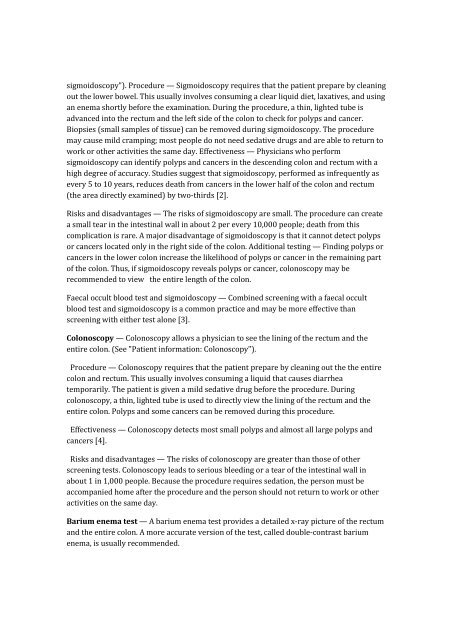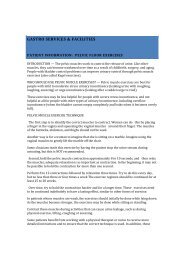Screening for colon cancer - Gastro Services and Facilities
Screening for colon cancer - Gastro Services and Facilities
Screening for colon cancer - Gastro Services and Facilities
Create successful ePaper yourself
Turn your PDF publications into a flip-book with our unique Google optimized e-Paper software.
sigmoidoscopy"). Procedure — Sigmoidoscopy requires that the patient prepare by cleaning<br />
out the lower bowel. This usually involves consuming a clear liquid diet, laxatives, <strong>and</strong> using<br />
an enema shortly be<strong>for</strong>e the examination. During the procedure, a thin, lighted tube is<br />
advanced into the rectum <strong>and</strong> the left side of the <strong>colon</strong> to check <strong>for</strong> polyps <strong>and</strong> <strong>cancer</strong>.<br />
Biopsies (small samples of tissue) can be removed during sigmoidoscopy. The procedure<br />
may cause mild cramping; most people do not need sedative drugs <strong>and</strong> are able to return to<br />
work or other activities the same day. Effectiveness — Physicians who per<strong>for</strong>m<br />
sigmoidoscopy can identify polyps <strong>and</strong> <strong>cancer</strong>s in the descending <strong>colon</strong> <strong>and</strong> rectum with a<br />
high degree of accuracy. Studies suggest that sigmoidoscopy, per<strong>for</strong>med as infrequently as<br />
every 5 to 10 years, reduces death from <strong>cancer</strong>s in the lower half of the <strong>colon</strong> <strong>and</strong> rectum<br />
(the area directly examined) by two-thirds [2].<br />
Risks <strong>and</strong> disadvantages — The risks of sigmoidoscopy are small. The procedure can create<br />
a small tear in the intestinal wall in about 2 per every 10,000 people; death from this<br />
complication is rare. A major disadvantage of sigmoidoscopy is that it cannot detect polyps<br />
or <strong>cancer</strong>s located only in the right side of the <strong>colon</strong>. Additional testing — Finding polyps or<br />
<strong>cancer</strong>s in the lower <strong>colon</strong> increase the likelihood of polyps or <strong>cancer</strong> in the remaining part<br />
of the <strong>colon</strong>. Thus, if sigmoidoscopy reveals polyps or <strong>cancer</strong>, <strong>colon</strong>oscopy may be<br />
recommended to view the entire length of the <strong>colon</strong>.<br />
Faecal occult blood test <strong>and</strong> sigmoidoscopy — Combined screening with a faecal occult<br />
blood test <strong>and</strong> sigmoidoscopy is a common practice <strong>and</strong> may be more effective than<br />
screening with either test alone [3].<br />
Colonoscopy — Colonoscopy allows a physician to see the lining of the rectum <strong>and</strong> the<br />
entire <strong>colon</strong>. (See "Patient in<strong>for</strong>mation: Colonoscopy").<br />
Procedure — Colonoscopy requires that the patient prepare by cleaning out the the entire<br />
<strong>colon</strong> <strong>and</strong> rectum. This usually involves consuming a liquid that causes diarrhea<br />
temporarily. The patient is given a mild sedative drug be<strong>for</strong>e the procedure. During<br />
<strong>colon</strong>oscopy, a thin, lighted tube is used to directly view the lining of the rectum <strong>and</strong> the<br />
entire <strong>colon</strong>. Polyps <strong>and</strong> some <strong>cancer</strong>s can be removed during this procedure.<br />
Effectiveness — Colonoscopy detects most small polyps <strong>and</strong> almost all large polyps <strong>and</strong><br />
<strong>cancer</strong>s [4].<br />
Risks <strong>and</strong> disadvantages — The risks of <strong>colon</strong>oscopy are greater than those of other<br />
screening tests. Colonoscopy leads to serious bleeding or a tear of the intestinal wall in<br />
about 1 in 1,000 people. Because the procedure requires sedation, the person must be<br />
accompanied home after the procedure <strong>and</strong> the person should not return to work or other<br />
activities on the same day.<br />
Barium enema test — A barium enema test provides a detailed x-ray picture of the rectum<br />
<strong>and</strong> the entire <strong>colon</strong>. A more accurate version of the test, called double-contrast barium<br />
enema, is usually recommended.



